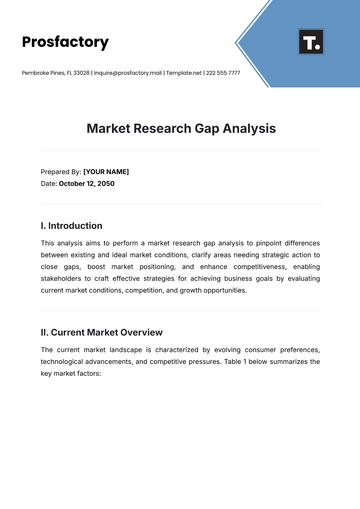Free Printable Patient Care Gap Analysis

Prepared By: [YOUR NAME]
Date: September 16, 2050
I. Current State
Patient care today reflects key practices and outcomes crucial for healthcare quality and efficiency. Protocols include routine exams, diagnostics, and treatments to meet health standards. However, inconsistencies and inefficiencies affect outcomes. Currently, patient satisfaction is at 75%, with delays in follow-ups, inconsistent education on disease management, and partial adherence to guidelines.
II. Desired State
The desired state in patient care focuses on achieving exemplary standards of health services that result in superior patient outcomes. This encompasses timely conduction of patient follow-up appointments, comprehensive patient education, and consistent adherence to the highest clinical guidelines by all staff members. We aim to elevate the patient satisfaction index to at least 90%, reduce follow-up appointment delays by 50%, and ensure complete educational resources are provided to all patients processed through our care system.
III. Gap Identification
There are several notable discrepancies between the current and desired state of patient care as outlined below:
Delay in scheduling and conducting follow-up appointments, leading to decreased patient care continuity.
Partial adherence to clinical guidelines compromises the consistency of care provided across the board.
Inadequate patient education resources contribute to lower levels of patient engagement and understanding of disease management and prevention.
Lower patient satisfaction index reflecting dissatisfaction with one or more facets of the care experience.
IV. Root Cause Analysis
A detailed investigation reveals the following underlying reasons for the current gaps in patient care:
Issue | Root Cause |
|---|---|
Delayed follow-up | Lack of staffing and ineffective scheduling systems lead to inefficiencies in managing patient appointment calendars. |
Inconsistent adherence to guidelines | Inadequate training and monitoring systems result in variability in staff adherence to clinical protocols. |
Inadequate patient education | Lack of updated educational materials and limited time per patient interaction reduce opportunities to provide comprehensive education. |
Low patient satisfaction | Perceived lack of personalized care and service delays are contributing factors to patient dissatisfaction. |
V. Action Plan
The steps to improve patient care and bridge the identified gaps are as follows:
Enhance staffing levels and implement an integrated electronic scheduling system to ensure timely follow-up appointments.
Conduct comprehensive training programs for all healthcare professionals to standardize adherence to updated clinical guidelines.
Develop and distribute updated educational materials focused on common conditions and preventive measures; allocate specific time for patient education during visits.
Initiate a patient feedback system to routinely gather insights and adjust services better to meet patient expectations and improve satisfaction indices.
VI. Timeline and Responsibilities
The timeline for implementing these changes is structured over the next six months. Key responsibilities are assigned as follows:
Action Item | Timeline | Responsible Party |
|---|---|---|
Enhance staffing and implement a scheduling system | 1-2 months | Human Resources, IT Department |
Comprehensive training programs | 1-3 months | Training and Development Team |
Develop educational materials | 2-4 months | Patient Education Committee |
Initiate a patient feedback system | 3-6 months | Patient Relations |
- 100% Customizable, free editor
- Access 1 Million+ Templates, photo’s & graphics
- Download or share as a template
- Click and replace photos, graphics, text, backgrounds
- Resize, crop, AI write & more
- Access advanced editor
Enhance healthcare delivery with the Printable Patient Care Gap Analysis Template from Template.net. This editable and customizable template is designed to identify gaps in patient care processes, ensuring improved outcomes. Use our AI Editor Tool to adapt the content to your healthcare setting with ease. Ensure high-quality care and better patient satisfaction with this ready-to-use template.





























